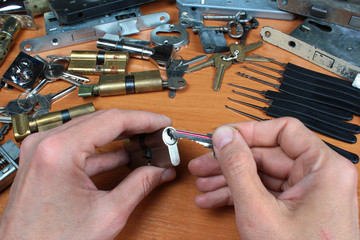Locks are essential for safety, security, and peace of mind. Whether it is a home, office, or vehicle, everyone relies on locks to protect valuables and loved ones. But when keys are lost, locks are damaged, or new systems are needed, locksmiths become the professionals people trust. Skilled in handling everything from emergency lockouts to advanced security installations, locksmiths provide services that are vital to modern living.

Who Are Locksmiths
Locksmiths are trained professionals who work with locks, keys, and security systems. Their expertise extends far beyond simply cutting keys or opening doors. They are problem solvers who specialize in repairing, replacing, and installing locking mechanisms to ensure safety and functionality.
Some of the most common tasks locksmiths handle include:
- Assisting with lockouts when keys are lost or left inside.
- Rekeying locks to work with new keys.
- Repairing damaged locks and mechanisms.
- Installing advanced locking and security systems.
- Duplicating keys for homes, businesses, or vehicles.
By offering these services, locksmiths provide convenience, protection, and peace of mind to their clients.
The Importance of Locksmiths
Locks are the first line of defense against unauthorized access, which makes locksmiths critical to everyday security. Their importance goes beyond emergencies and includes:
- Protecting Property: By ensuring locks are functional and durable, locksmiths help safeguard homes and businesses.
- Enhancing Security: Locksmiths recommend and install updated locking systems that resist tampering.
- Providing Peace of Mind: Knowing locks are reliable allows people to feel safe in their environments.
- Assisting in Emergencies: Being locked out is stressful, but locksmiths provide quick solutions.
- Maintaining Functionality: Regular maintenance of locks prevents unexpected breakdowns.
Without locksmiths, the reliability of security systems would be compromised, leaving people and their property vulnerable.
Skills and Training of Locksmiths
Becoming a locksmith requires a unique blend of technical skill, mechanical ability, and problem-solving talent. Training typically involves hands-on experience and learning about:
- Lock mechanisms and key systems.
- Safe opening techniques.
- Key cutting and duplication.
- Advanced electronic and digital locks.
- Security assessments and system upgrades.
Locksmiths also develop strong customer service skills, as their work often involves helping people in stressful situations such as being locked out of their homes or vehicles.
Residential Locksmith Services
One of the most common areas where locksmiths are needed is in residential settings. Homeowners rely on them to ensure their families and property are safe. Residential locksmith services include:
- Rekeying or changing locks after moving into a new home.
- Repairing worn or broken locks on doors and windows.
- Installing deadbolts and security upgrades.
- Providing duplicate keys for household members.
- Offering emergency lockout assistance.
By addressing these needs, locksmiths help homeowners maintain both security and convenience.
Commercial Locksmith Services
Businesses also depend heavily on locksmiths to secure their property, assets, and employees. Commercial locksmith services often involve more advanced systems designed to manage multiple access points. Common services include:
- Installing high-security locks and access control systems.
- Setting up master key systems for easy management.
- Repairing or replacing locks on office doors, safes, and storage units.
- Enhancing overall security with upgraded hardware.
- Responding quickly to emergency lockouts that interrupt business operations.
For businesses of all sizes, locksmiths play an essential role in protecting assets and ensuring smooth day-to-day operations.
Automotive Locksmith Services
Vehicles rely on complex lock and key systems that require specialized expertise. Automotive locksmiths focus on helping drivers with issues such as:
- Unlocking cars when keys are locked inside.
- Cutting and programming replacement keys.
- Repairing ignition systems or key fobs.
- Assisting with broken or jammed keys in locks.
- Providing emergency roadside locksmith services.
This area of locksmithing requires technical training, as modern vehicles often use advanced electronic keys and security systems.
Emergency Locksmith Services
Emergencies happen unexpectedly, and locksmiths are often available around the clock to assist. Common emergency services include:
- Helping people regain access to homes, offices, or vehicles.
- Repairing locks after a break-in or attempted burglary.
- Replacing lost or stolen keys quickly.
- Fixing malfunctioning locks that pose safety risks.
Emergency locksmiths provide reassurance during stressful situations, offering fast and reliable solutions.
The Evolution of Locksmithing
Locksmithing has evolved significantly over time. While traditional locks and keys remain important, modern locksmiths now work with electronic systems, smart locks, and digital access controls. This evolution reflects the growing need for advanced security in both residential and commercial settings.
Today’s locksmiths stay updated on new technologies, learning how to install and service keyless entry systems, biometric locks, and smart security devices. This adaptability ensures locksmiths remain relevant in an ever-changing industry.
Choosing a Reliable Locksmith
When selecting a locksmith, it’s important to look for qualities that ensure trust and reliability. Key considerations include:
- Experience and Training: Skilled locksmiths can handle a wide range of issues effectively.
- Professionalism: Good communication and customer service are essential.
- Availability: Emergency situations require locksmiths who are accessible anytime.
- Transparency: Clear pricing and explanations build trust.
- Reputation: Positive reviews or recommendations demonstrate reliability.
Selecting the right locksmith ensures your security needs are met with professionalism and care.
Locksmiths are essential professionals who keep homes, businesses, and vehicles secure. Their expertise goes beyond cutting keys, extending into advanced security systems and emergency services. From residential lock repairs to commercial security upgrades and automotive assistance, locksmiths play a vital role in modern life.
As technology continues to evolve, locksmiths adapt to meet new challenges, ensuring safety and convenience for everyone. Whether facing an emergency lockout or planning a security upgrade, locksmiths provide the solutions needed to protect what matters most.